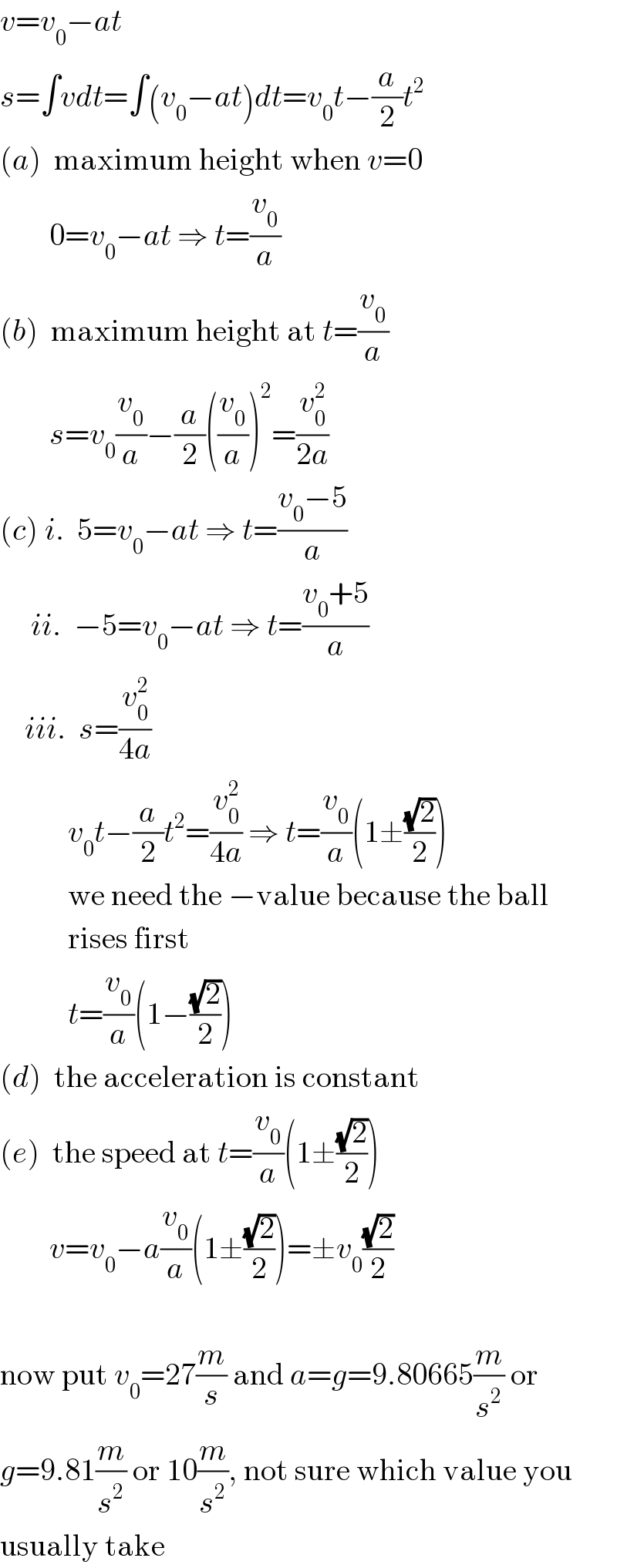
Question Number 75351 by TawaTawa last updated on 10/Dec/19

Answered by MJS last updated on 10/Dec/19

$${v}={v}_{\mathrm{0}} −{at} \\ $$$${s}=\int{vdt}=\int\left({v}_{\mathrm{0}} −{at}\right){dt}={v}_{\mathrm{0}} {t}−\frac{{a}}{\mathrm{2}}{t}^{\mathrm{2}} \\ $$$$\left({a}\right)\:\:\mathrm{maximum}\:\mathrm{height}\:\mathrm{when}\:{v}=\mathrm{0} \\ $$$$\:\:\:\:\:\:\:\:\mathrm{0}={v}_{\mathrm{0}} −{at}\:\Rightarrow\:{t}=\frac{{v}_{\mathrm{0}} }{{a}} \\ $$$$\left({b}\right)\:\:\mathrm{maximum}\:\mathrm{height}\:\mathrm{at}\:{t}=\frac{{v}_{\mathrm{0}} }{{a}} \\ $$$$\:\:\:\:\:\:\:\:{s}={v}_{\mathrm{0}} \frac{{v}_{\mathrm{0}} }{{a}}−\frac{{a}}{\mathrm{2}}\left(\frac{{v}_{\mathrm{0}} }{{a}}\right)^{\mathrm{2}} =\frac{{v}_{\mathrm{0}} ^{\mathrm{2}} }{\mathrm{2}{a}} \\ $$$$\left({c}\right)\:{i}.\:\:\mathrm{5}={v}_{\mathrm{0}} −{at}\:\Rightarrow\:{t}=\frac{{v}_{\mathrm{0}} −\mathrm{5}}{{a}} \\ $$$$\:\:\:\:\:{ii}.\:\:−\mathrm{5}={v}_{\mathrm{0}} −{at}\:\Rightarrow\:{t}=\frac{{v}_{\mathrm{0}} +\mathrm{5}}{{a}} \\ $$$$\:\:\:\:{iii}.\:\:{s}=\frac{{v}_{\mathrm{0}} ^{\mathrm{2}} }{\mathrm{4}{a}} \\ $$$$\:\:\:\:\:\:\:\:\:\:\:{v}_{\mathrm{0}} {t}−\frac{{a}}{\mathrm{2}}{t}^{\mathrm{2}} =\frac{{v}_{\mathrm{0}} ^{\mathrm{2}} }{\mathrm{4}{a}}\:\Rightarrow\:{t}=\frac{{v}_{\mathrm{0}} }{{a}}\left(\mathrm{1}\pm\frac{\sqrt{\mathrm{2}}}{\mathrm{2}}\right) \\ $$$$\:\:\:\:\:\:\:\:\:\:\:\mathrm{we}\:\mathrm{need}\:\mathrm{the}\:−\mathrm{value}\:\mathrm{because}\:\mathrm{the}\:\mathrm{ball} \\ $$$$\:\:\:\:\:\:\:\:\:\:\:\mathrm{rises}\:\mathrm{first} \\ $$$$\:\:\:\:\:\:\:\:\:\:\:{t}=\frac{{v}_{\mathrm{0}} }{{a}}\left(\mathrm{1}−\frac{\sqrt{\mathrm{2}}}{\mathrm{2}}\right) \\ $$$$\left({d}\right)\:\:\mathrm{the}\:\mathrm{acceleration}\:\mathrm{is}\:\mathrm{constant} \\ $$$$\left({e}\right)\:\:\mathrm{the}\:\mathrm{speed}\:\mathrm{at}\:{t}=\frac{{v}_{\mathrm{0}} }{{a}}\left(\mathrm{1}\pm\frac{\sqrt{\mathrm{2}}}{\mathrm{2}}\right) \\ $$$$\:\:\:\:\:\:\:\:{v}={v}_{\mathrm{0}} −{a}\frac{{v}_{\mathrm{0}} }{{a}}\left(\mathrm{1}\pm\frac{\sqrt{\mathrm{2}}}{\mathrm{2}}\right)=\pm{v}_{\mathrm{0}} \frac{\sqrt{\mathrm{2}}}{\mathrm{2}} \\ $$$$ \\ $$$$\mathrm{now}\:\mathrm{put}\:{v}_{\mathrm{0}} =\mathrm{27}\frac{{m}}{{s}}\:\mathrm{and}\:{a}={g}=\mathrm{9}.\mathrm{80665}\frac{{m}}{{s}^{\mathrm{2}} }\:\mathrm{or} \\ $$$${g}=\mathrm{9}.\mathrm{81}\frac{{m}}{{s}^{\mathrm{2}} }\:\mathrm{or}\:\mathrm{10}\frac{{m}}{{s}^{\mathrm{2}} },\:\mathrm{not}\:\mathrm{sure}\:\mathrm{which}\:\mathrm{value}\:\mathrm{you} \\ $$$$\mathrm{usually}\:\mathrm{take} \\ $$
Commented by TawaTawa last updated on 10/Dec/19

$$\mathrm{God}\:\mathrm{bless}\:\mathrm{you}\:\mathrm{sir},\:\:\mathrm{thanks}\:\mathrm{for}\:\mathrm{your}\:\mathrm{time} \\ $$
